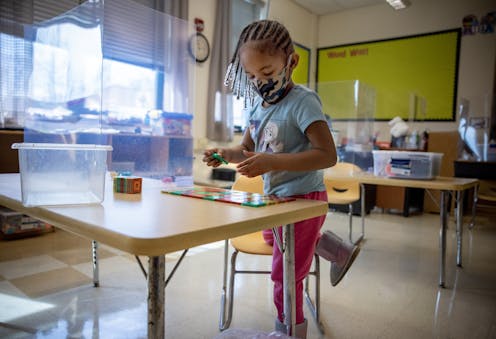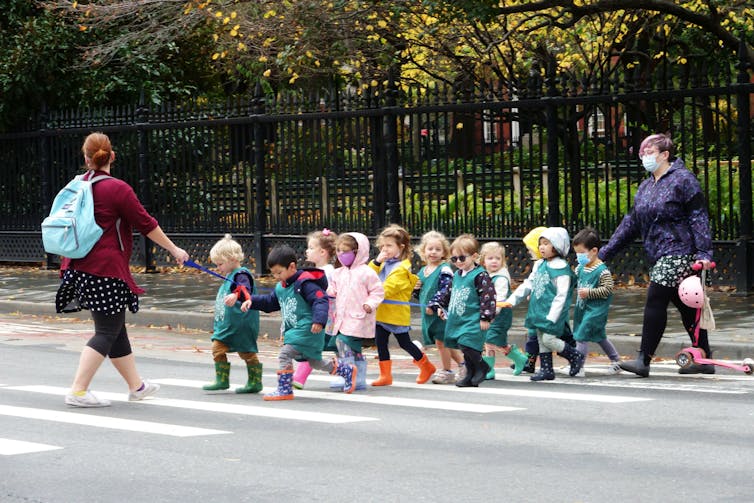President Biden's plan for free universal preschool – 5 questions answered
An early childhood education expert explains what's in the proposal and why it's not really a partisan issue.

From New York City to Washington, D.C. and Oklahoma to Colorado, a handful of U.S. cities and states have opted to fund universal preschool for their youngest residents. That benefit may soon be available to every 3-year-old and 4-year-old across the country.
Dr. Christina Weiland, associate professor at the University of Michigan, studies how early childhood programs and public policies impact children’s development. Here, she answers five questions parents and caregivers may have about the Biden administration’s plan for universal preschool.
1. What exactly is Biden proposing?
The proposal would mean that every kid in America could, if their family wants them to, attend a publicly supported preschool program starting at age 3. Currently, children of wealthy families overwhelmingly go to preschool, and families with middle and low incomes often really struggle to find slots and to access the same quality of programs.
The proposal also includes funding for what the Biden administration is calling “high-quality and developmentally appropriate curriculum” as well as on-the-job coaching for teachers.
And finally, the teachers in these new universal preschool programs would be paid in line with K-12 teachers, if they have comparable qualifications, and a minimum of US$15 per hour otherwise.
In some places there’s a really large gap in terms of funding for teacher pay. For example, in Michigan, where I live, even though we require the same education background, we pay public preschool teachers a significant amount less than their K-12 counterparts. That fuels turnover issues, which also means some of the investments to improve preschool end up being wasted.
2. Where will the preschool programs be located?
Although the details haven’t been specified yet, it’s a safe bet they will be located in public schools, community-based preschools and perhaps some home-based child care programs, just as almost all state-funded public schools programs are.
3. What does a ‘high-quality’ curriculum mean?
There’s often a false dichotomy that a preschool is either “academic” or “play-based.” But high-quality preschools are both play-based and academic – because that’s how young children learn, through play. A really good curriculum involves kids having fun, using different materials and using their bodies. The key is that a good preschool curriculum is also intentional. That means that new concepts and skills are presented in an order that matches how young children learn and develop. They also are designed so that teachers can meet individual children where they are, at their developmental level.
The most effective preschool curricula are developed by experts in a particular area – such as literacy – and are designed with a set of fun, play-based activities that match the science of how kids learn early skills. A current problem is that most public preschool and Head Start programs in the U.S. use more general curricula that are fun but not aligned with this science. Their activities don’t necessarily follow the predictable order in which young children learn new concepts and skills.

4. Can you explain the ‘targeted’ versus ‘universal’ arguments around funding for preschool?
Those who advocate for a targeted approach argue that if people can afford to pay for private preschool for their children, those public dollars are better spent on a different need. They point to evidence that children from less advantaged backgrounds benefit from attending preschool more than their wealthier peers, so they argue that targeted programs offer more bang for the buck.
[Get the best of The Conversation, every weekend. Sign up for our weekly newsletter.]
On the universal side, there is evidence that all children benefit from high-quality public preschool and that children from families with low incomes learn less in targeted programs. There are also folks who argue that just sorting out who’s eligible and who’s not comes with bureaucratic costs. And whenever there are bureaucratic hurdles for any program, some families – particularly those with children who might benefit most – will be left out.
5. Is universal preschool a partisan issue?
It may become a partisan issue getting the Biden administration’s plan through Congress, but at the state and local levels, universal preschool is not a red or blue issue. For example, Oklahoma and West Virginia have long offered a preschool seat to all their 4-year-olds, and they are deeply red states.
Colorado voters in 2020 approved a cigarette and vape tax to fund universal free preschool for 4-year-olds statewide starting in 2023. And voters in cities like Dayton, Ohio, Cincinnati, Seattle and Portland, Oregon have approved ballot initiatives to tax themselves to offer free preschool.
There’s a lot of will and bipartisan support across the country for these kinds of programs. People recognize the benefits of attending preschool, the high costs that put preschool out of reach for many working families, and working parents’ needs and preferences for a stimulating, safe environment for their young children.
Christina J. Weiland receives grant funding from Institute of Education Sciences, the Heising-Simons Foundation, the Foundation for Child Development, and the Spencer Foundation.
Read These Next
From truce in the trenches to cocktails at the consulate: How Christmas diplomacy seeks to exploit s
World leaders like to talk up peace at Christmastime. But alongside the tales of seasonal breaks in…
As DOJ begins to release Epstein files, his many victims deserve more attention than the powerful me
Powerful men connected to Jeffrey Epstein are named, dissected and speculated about. The survivors,…
How to reduce gift-giving stress with your kids – a child psychologist’s tips for making magic and a
Depending on family circumstances and a child’s personality type, gift giving runs the gamut of fun…






